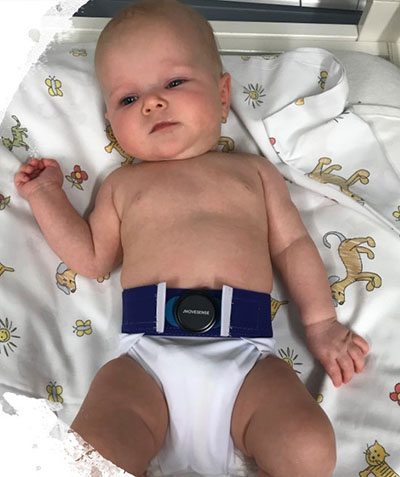Sleep pants and artificial intelligence help with babies’ sleep problems
Neurological research of infants is still mostly conducted through observation, which makes it challenging to predict abnormal development. Sleep pants that utilise artificial intelligence can give a doctor information that cannot be obtained through discussions with the parents or seeing the baby at the practice. Sampsa Vanhatalo, Professor in Clinical Neurophysiology at the University of Helsinki, leads RIB, a research project that aims to develop solutions to diagnostics and mobile monitoring of treatment of early infant brain activity. The sleep pants are developed together with researcher Elina Ilén from Aalto university. The research is conducted at the BABA Centre at the Children’s Hospital. It is a part of the Health from Science (TERVA) research programme that aims to seek bold, new research initiatives that can solve health issues related to major public health diseases.
Up to 40 per cent of parents think that their baby sleeps poorly. The sleep pants could help the parents’ distress. ”We have proof that a baby’s sleep is interrupted by many children’s diseases, such as infections, but also by things that disturb the mother’s well-being, such as depression. The sleep pants can also detect periodic breathing that appears during the first months and often demands care”, says Vanhatalo. The sleep pants can be used to find out what kind of breathing or movement is normal and what kind requires attention.”We have noticed that breathing rhythm and its regularity are a good indicator of a child’s sleep cycle. We can quite reliably perceive the child’s deep and light sleep stages just by observing breathing.”

In practice the sleep pants use a small sensor that monitors breathing. The sensor is attached to the pants on the waist, below the navel. The information on breathing movement is transferred via a Bluetooth connection to a smartphone, where the data is unpacked and transferred to be analysed by an artificial intelligence algorithm. The algorithm recognises the deep and light sleep stages and interprets changes in breathing. To date, the pants have been tested in the Children’s Hospital when using the EEG or the sleep laboratory. An official sleep study such as this can be used to teach the AI algorithm. Eventually, it will learn to recognise the sleep stages independetly. The pants have been tested overnight at the patient’s home, which confirmed that dependable monitoring is possible also long term.
The development of the sleep pants is well advanced: during the coming winter the pants and the background algorithm will form a prototype that is ready for the field. In the future, the pants are hopefully used in the everyday home life that is the natural habitat of infants. Parents could borrow the clothes in child health clinics. The measured results could then be analysed in an online service.
The project consortium Rhythms in Infant Brain: Wearables for Computational Diagnostics and Mobile Monitoring of Treatment (RIB) comprises research groups from the University of Helsinki, Aalto University and University of Turku with the foremost experts in different fields. The project includes textile engineers, medical doctors, mathematicians, physicists and AI experts, which enables versatile networking. There are rarely opportunities for textile engineers to be involved in pediatrics research. In addition to the Academy, the project is funded by Lastentautien tutkimussäätiö (Foundation of Pediatrics Research) and Aivosäätiö (Finnish Brain Foundation).
More information and inquiries
- Sampsa Vanhatalo, University of Helsinki, tel. +358 50 5286119, firstname.lastname(at)helsinki.fi